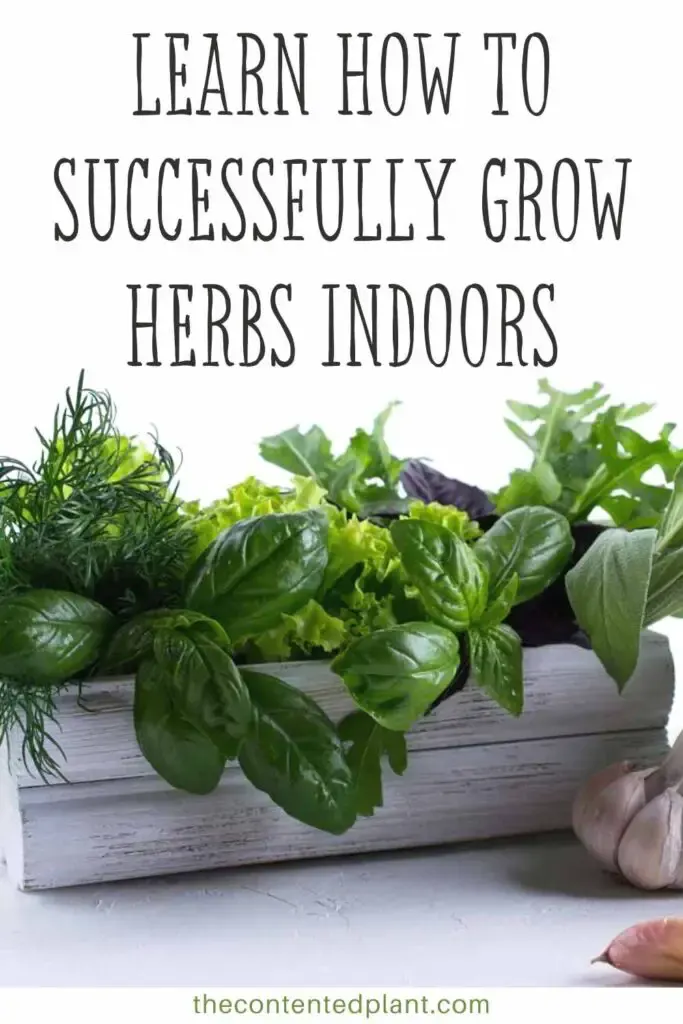Growing herbs indoors produces fresh herbal leaves(and stems) for flavoring recipes right at your fingertips. Snipping fresh leaves off your herbs adds fresh authentic herbal flavors and textures into your favorite dishes.
Some herbs also have therapeutic uses making them good candidates for homemade teas, tonics, creams, lotions and tincture recipes.
Growing your most used medicinal and culinary herbs indoors keeps them available year round when needed.
Kitchens are the most convenient place to place your indoor herbs. But herbs will thrive in any sunny spot in your home.
If you have room and bright sunlight in your kitchen, set out a few pots of herbs. Plant your favorite leafy friends in really cute containers and proudly display them in bright areas of your home and kitchen. Or leave them in a mish mash of garden pots for an authentic, rustic farmhouse look.
Culinary herbs add scents, lively green color, a variety of plant shape and various leaf sizes and textures wherever you place them.
Herbs can be grouped in large planters or planted individually in planter sets. Go rustic or clean minimalist in style. Herbs will look great in any style kitchen with the proper presentation.

Best herbs to grow indoors:
Indoor herb growing works best if you choose herbs that are known to do well indoors. However, You CAN bring ANY herb indoors from your garden or purchase starts of herbs that you use often for at least part of the year.
Here are some commonly used kitchen herbs that do well indoors.
| Basil Bay laurel Chives Cilantro Dill | Lemongrass Marjoram Oregano Parsley | Rosemary Stevia Thyme Tri-color sage |
Indoor herb growing gives your kitchen a fresh organic vibe. Many cooks keep their favorite herbs in pots close to their sinks on windowsills or shelves for convenience.
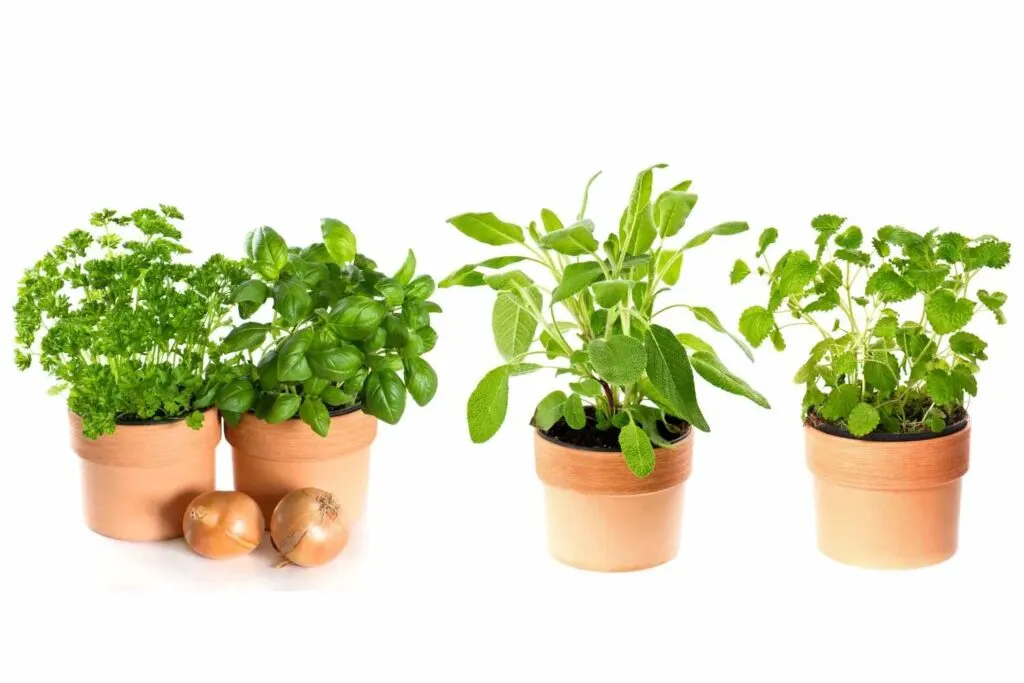
Most herbs will grow quite easily outdoors year after year. Bees LOVE flowering herbs and pollinate them very well. Mature Herb seeds scatter around and pop up all over the garden in the following years. In fact, many herbs get invasive outdoors.
Oregano, mint and many other herbs can become a problem if they get out of hand. Even crowding out other plants in the garden.
Growing herbs like these in pots indoors ensures they won’t take over outside growing areas.
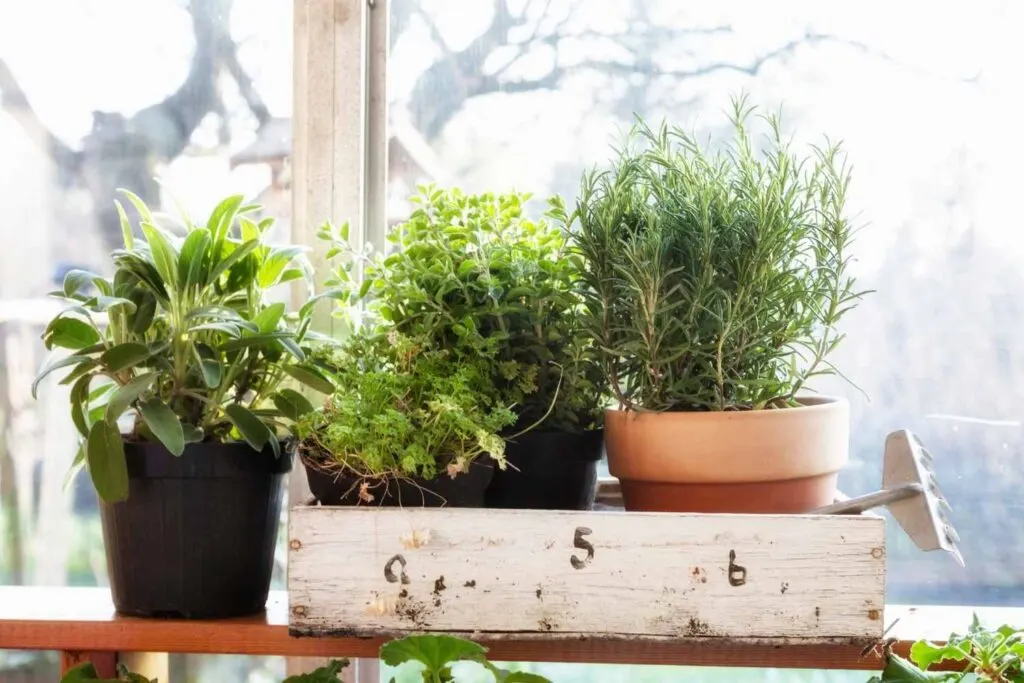
Sourcing Herbs to Grow Indoors:
Finding fresh Kitchen herbs to grow indoors is not hard in the growing months.
- Buy organic herb starts at your local garden shop, or farmers market. Set the pot on your sunniest window and, if all goes well, you’ll be pruning off leaves in no time.
- You can also bring in those pesky invasive herb starts or cuttings from your own outdoor herb garden. Or grab a small herb start from a gardening friend.
- You will need to repot herbs brought in from the garden in new potting soil. Add a good mix of inorganic draining mediums, like perlite, into the soil so the plant has good drainage.
- Do NOT bring new herbs into your kitchen unless you THOROUGHLY check them for pests. It’s a good idea to give the stems and leaves a good strong shower, both on the leaf top and bottoms to remove any pests. If pests persist, take the pot of herbs outdoors and try again. Plant pests do NOT belong in the home. They will infest other houseplants around them. Not sure if you have pests? Read our post on the 7 common plant pests here.
- Order starts online if you can’t find them locally. We recommend ETSY shops for herb seeds, plants and the tools to harvest and grow them indoors. Page Linked Below.
- If you can’t find healthy starts of the herbs you want to grow indoors, try ordering seeds. Just follow the package instructions. However, Starting herbs from seed is a loooong process and it does not always work well indoors. This is a last resort to source herbs for growing indoors. Its normally quite easy to find good herb starts locally or online.
Shop ETSY for Herb Starts, planters and tools specific to growing and harvesting herbs indoors.

How to Grow Herbs Indoors:
Growing herbs indoors helps contain herbs and keeps them close at hand. Running around the garden snipping flavorful herbs for the recipe you are making in the cold and rain can be quite inconvenient. Ask me how I know. 🙂
Bringing herbs in for the winter or growing herbs in doors year round is convenient. Here’s how to keep herbs thriving indoors year round.
Care Tips For Indoor Herbs:
Herbs must have Bright light and humidity to grow well indoors. But there is more than that. Correct soil and Watering is vital to avoid root rot.
Here is a quick guide to caring for most kitchen herbs indoors.
| Plant: | Various Kitchen Herbs |
| Care Difficulty: | moderately easy |
| Temperature: | 50 to 70 degrees F. |
| Watering: | water when soil is almost dry. Herbs need even moisture so check weekly. |
| Soil: | potting soil mixed with perlite at 60/40% |
| Lighting: | Bright direct or Artificial lighting |
| Growth: | Most herbs grow as small bushes |
| Pruning: | Snip off the leaves as needed for use and to keep the plant well shaped and sized. |
In the growing months, herbs normally do quite well in strongly lit windows by the sink. they love light and humidity. a southern or western facing kitchen window with a sink nearby is a good placement for herbs.

If you grow herbs grouped in a planter, it’s simple to set the pot outside your kitchen door or on a patio in the warm sunny months for easy harvest.
However, herbs will require special handling to keep them producing the healthy growing leaves we covet in winter.
Tips For Growing Herbs Indoors in Winter:
When the seasons change and nighttime temperatures drops to 50 degrees F. you can bring herbs into the house to keep the herbs alive.
You can also pot up some starts from your garden or purchase some in late summer to Fall for growing indoors through the winter.
Remember, Herbs love bright light and humidity. Growing herbs indoors requires you to give them the strong bright light and humidity they need. Herbs grow well in strong sunlight. Even the brightest indoor light will not match natural sunlight.
During the dark winter months Keeping your houseplants alive in winter can be a challenge. We can, and should, let our ornamental houseplants go dormant in winter since they benefit from a resting period.
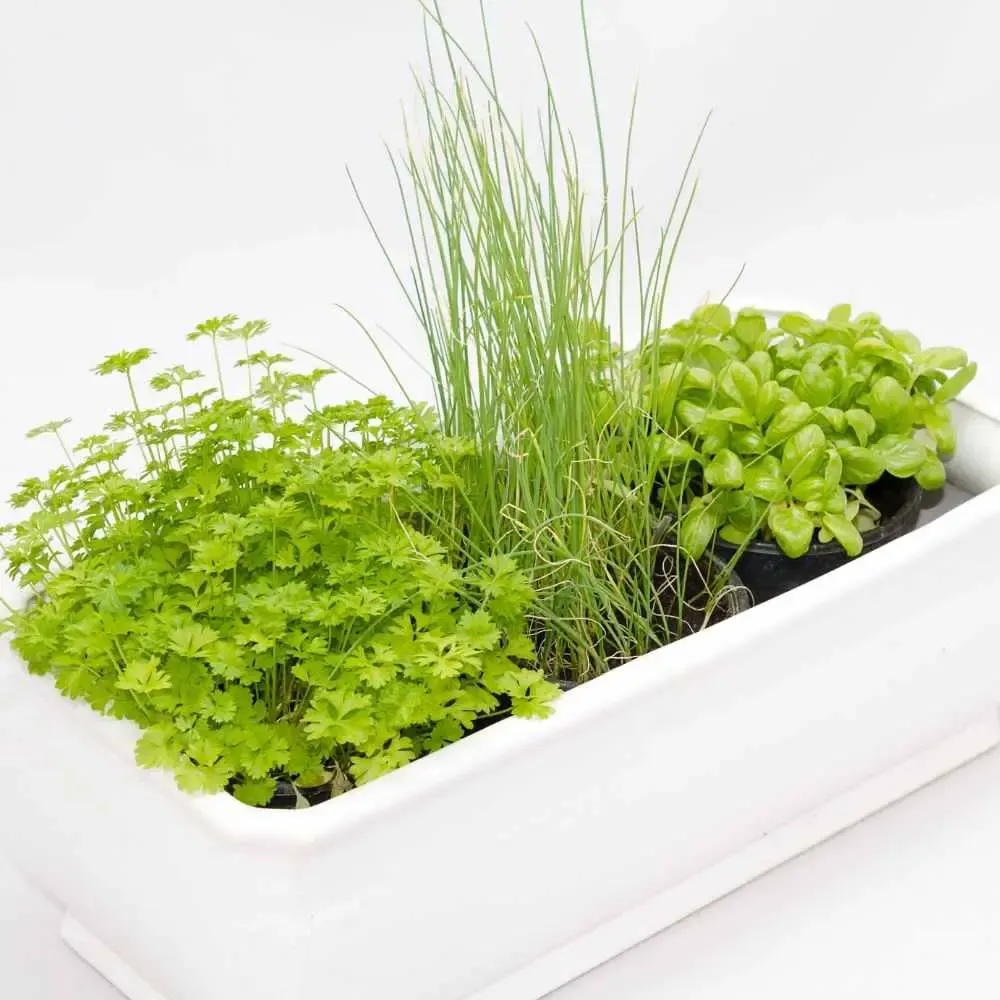
Growing herbs indoors in winter is different. This is a food crop as well as an ornamental. We want to snip leaves off our herbs in winter to use them in recipes. They need to stay lush, nutritious and growing throughout the long winter months.
In temperate and colder climates this may not be easy. Northern areas of the globe have short, dark days with little natural sunlight. Sometimes less than 6 hours of natural light a day.
If we allow herbs to go dormant they will not be available for culinary use until Spring when the light cycle lengthens, the temperatures warm and the plant begins growing again.
Even after the live herbs perk up, we need to wait until the plant is ready to prune. In some areas this can take long into Spring. It all depends on where you live.
A well lit south facing sun room is ideal for indoor herbs in winter. Although any strongly lit southern or western window will help your herbs retain vitality in winter.
When to Add Artificial Lighting:
Artificial grow lighting will help keep the herbs in tip top shape where winter light is just not strong enough. How do you know when it is time to add grow lights to your herbs?
Herbs tend to go into dormancy when the light in your home dims and the number of hours of light drops to 6 hours a day. The plant will slow down its growth (or stop altogether) when the light is too low. The leaves, if they continue to grow, may get smaller and less vibrant.
If you see the plants get leggy and stretching for the light, they are showing you it’s time for more light. Either move them to a brighter area of your home or add supplemental artificial grow lights like these from Amazon.
To keep your herbs growing in winter you have to fool them into thinking it is the growing season. Add light and keep the temperatures over 60 degrees F to convince them it’s spring or summer.
A slow release fertilizer will also help keep the plant well fed and nutritious all year long. Just be sure you are using organic fertilizer and soil for your herbs.
Adding Humidity:
Indoor herb growing in the Cold winter months also offers the challenge of dry air. Drier air is a consequence of forced air heating systems.
When your herb leaves get crispy brown tips, they may need more humidity.
Ways to Add Humidity to Indoor Herbs:
- Grow herbs close together. They will respire and share moisture as it evaporates into the air. Grouping lots of herbs into a single planter.
- Place your grouping of herb pots on a pebble tray. Keep water in the pebbles so they will evaporate up into the herb leaves.
- In extremely dry air you may need to add a humidifier close by your herbs to keep the leaves lush and well hydrated.
- Some herbs can be misted to keep the leaves hydrated. Others will grow molds and fungus on too wet leaves. Be sure you know which herbs will benefit from misting before you use this method.

Harvesting Indoor Herbs -Tips and Uses:
Prune off Flower Heads: Most culinary herbs are grown for the leaves rather than the sticks and flowers. A flowered herb will put most of its energy into the seed head. The leaves will get tough, sparse and smaller as the flower head matures.
It is best to prune off the flower buds of your herbs if you want to keep the leaves in good health and flavor.
For most herbs we want the leaves. Snip off the branch and strip the leaves to add leaves directly to your recipe.
The stems of some herbs, like the woody stemmed rosemary, will give you sticks with lots of flavor to add to soup broths and homemade bone broths (I make my bone broth in my instant pot like this).
Preserving Herbs:
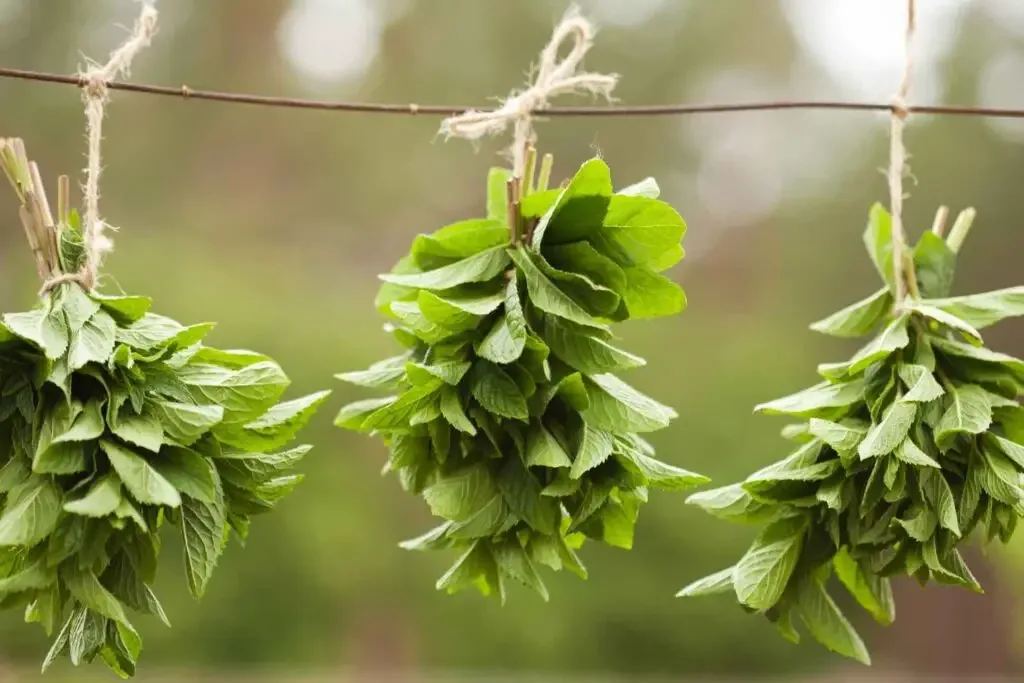
If your plant is growing fast and you want to do a hard prune to keep it smaller, you can preserve the excess herb leaves and stem by drying and freezing.
- Dry herbs by hanging them to air dry, dry them on a rack in your oven(lowest heat) or food dehydrator.
- Grind up the dried herbs into powder or use them in pieces from the dried branches.
- Fresh herbs can also be frozen either the leaves only or with stems.
- Freeze herb leaves in ice cube trays to drop into soups, stir fries and stews.
- Put the herbs in a zip lock freezer bag sticks and all or just leaves.
- You can freeze herbs singly or in your favorite leafy herb blends. Squeeze out all the air from the freezer bag and lable the bag.
- Once frozen, remove what you need from the bag and set the bag back in the freezer (tightly rolled) for lots of uses over the next several months.
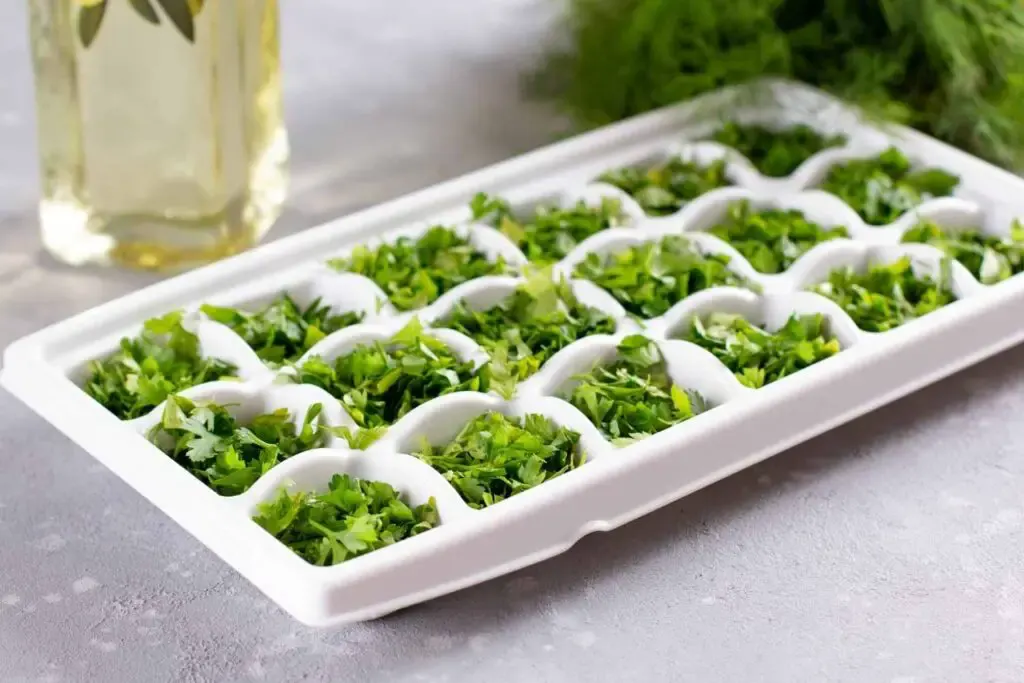
Summary:
With adequate light, good soil and humidity, you can count on most kitchen herbs growing well indoors, even through the winter months.
Fresh herbs indoors offer culinary scents, lively color and texture to your kitchen and home.
Preserving herbs by drying or freezing is simple and rewarding. Growing and preserving your own herbs is creative, nurturing , improves your home environment since most will filter the air and can save you money too.
Plants and people go together. Live greenery is therapeutic for humans and Improves our Home Environment.
